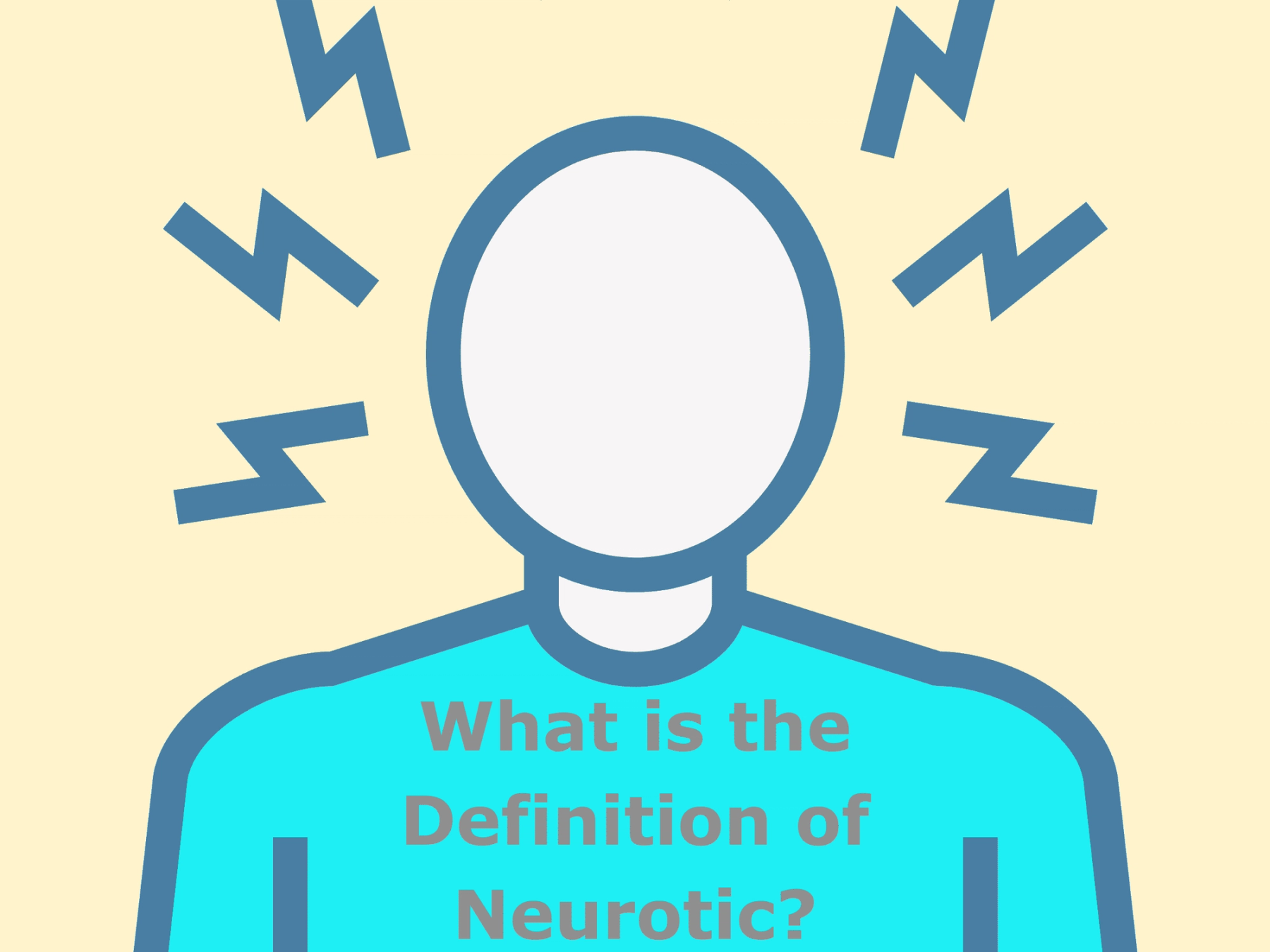March 31st, 2021

You may often hear the term, “neurotic,” thrown around in casual conversations, perhaps labeling a friend or foe. But what does the declaration really mean? What was once considered a broad category of conditions associated with poor functioning, anxiety, and depression, is now a generalization of high-strung, tense, or moody individuals. So wherein lies the truth?
The textbook definition of “neurotic” states, “suffering from, caused by, or relating to neurosis.” According to the Merriam-Webster dictionary, neurosis is “a mental and emotional disorder that affects only part of the personality, is accompanied by a less distorted perception of reality than psychosis, does not result in disturbance of the use of language, and is accompanied by various physical, physiological, and mental disturbances.”
Aside from the dictionary descriptions outlined above, there is no single “neurotic definition.” Some psychologists and psychiatrists use the term to describe a spectrum of mental illnesses outside of psychotic disorders. Other doctors use the term to refer to anxious symptoms and behaviors. Dr. William Cullen coined the term in the 18th century as a concept that encompasses nervous disorders and symptoms that do not have a clear cause. Following Cullen, Sigmund Freud used the term, “anxiety neurosis” to describe mental illness or distress with extreme anxiety as a defining feature.
For Freud, neuroticism was essentially boiled down to a conflict between two opposing forces, one of a libidinal type and one of a perceptive type. The conflict between the two was the source of neurotic symptoms. One way to think about the forces is as “external” and “internal.” Take the pain, for example. Pain has both an external force (i.e. the harmful action) and an internal force (i.e. our ability to recognize the signal of pain). The meeting here results in a kind of “symptom,” where you might yell out, cry, curse yourself, and so on. We can think about Freud’s conception of neurosis in much the same way.
Before doing that, it might be appropriate to define more clearly what is meant by “libidinal” in psychoanalytic work. Whereas we tend to think now of “libido” as referring primarily to sexual energy (and indeed, Freud often reduced libido to this meaning. When thinking about Freud in this regard, it is important to remember that he lived and worked during a time when sex was very strictly taboo, in contrast to today), in psychoanalysis, the term has much more to it than that. Something in which we are libidinally invested can more broadly refer to anything that has a strong “emotional” connection to us, our history, our personality, and so on. A particularly happy memory of a childhood birthday, for example, might be libidinally charged; or we might get into a heated argument over something with another person that takes on a libidinal charge. Freud believed that “libido” was primarily broken down into sexual and aggressive types, and while those are indeed some things that we are invested in, subsequent work in psychoanalysis has broadened those horizons.
With that in mind, we can turn back to the idea of conflict and how it is the source of symptoms in Freud. When some event (or a memory of it) receives a heavy emotional investment from us that is deemed unacceptable (it makes us feel immoral or guilty, it repulses us, we are ashamed by it, it seems disproportionate, it frightens us, or anything else like this), it is met by our minds with a defense to keep us “stable” in light of what that event might mean. The result of that defense is a symptom. Take a childhood trauma as an example: someone who was attacked by an animal as a child has to “deal with” the fact that they were attacked, but also might feel as though they can’t “blame” the animal (“I was provoking it when I tried to pet it,” might be something the person says). The thing deemed “unacceptable” here might be that the person does, at least to a certain degree, “blame” the animal for attacking them. But since this is “unacceptable” to the person, it has to be defended against by the psyche, and seek expression in another form—the neurotic symptom, in this example perhaps a phobia.
Freud further broke down neurosis into two general categories: hysteria and obsession.
The hysteric’s symptoms take on a myriad of presentations, including conversion symptoms
where the conflict would be found in an otherwise physical form (for example, a verbal tic), mood disorder, or eating disorders. Obsession, on the other hand, takes the form of being “lost in thought,” so to speak, where the obsessive is captivated with their work, routines, and rituals, or something else. As mentioned above, Freud also had other “minor” classifications for neurosis. Subsequent work in psychoanalysis has developed its views on the mechanisms that produce neurosis. Jacques Lacan, for example, viewed neuroticism as a kind of question that a person asks themselves about what it means to “be” this or that kind of person.
In general, “neurosis” is no longer used as a diagnostic category by American psychologists and psychiatrists, and was removed from the American Psychiatric Association’s Diagnostic and Statistic Manual of Mental Disorders’ third edition in 1980 (last appearing as a diagnostic category in DSM-II).
Some physicians hope the term “makes a comeback” and carries a less negative connotation. The term “neurotic” can present in various ways and we will outline how the term is still used and how it can be helpful in framing human difficulties and suffering.
The most important thing to distinguish when using the term “neurotic” is to know whether it’s referring to personality traits or character adaptations.
Personality traits are longstanding patterns of thoughts, feelings, and actions which tend to stabilize in adulthood and remain relatively fixed.
There are five broad trait domains, one of which is labeled “neuroticism,” and it generally corresponds to the sensitivity of the negative affect system, where a person high in neuroticism is someone who worries, easily upsets, is often down or irritable, and demonstrates high emotional reactivity to stress.
In contrast, traits are broad descriptions of tendencies, and character adaptations are the situation-specific ways people adjust to the environment. Here the term neurotic refers to maladaptive coping strategies driven by fear or anxiety (which can be conscious or
subconscious) elicited by a certain kind of situation. Maladaptive, meaning the response ultimately moves the individual away from their long-term goals and needs.

A good example of this would be a person who gets upset if their date is even 10 minutes late and riddled with anxious dependency, they reach out for assurance in a panicked manner, demanding when the date will be arriving, asking if they are canceling. The date may respond that they will be right there, easing the short-term anxiety, but the behavior of the anxious party provokes an opposite long-term effect – and the date has likely labeled the person as needy and dependent. The date would probably avoid that person in the future, which was the fear of the frantic person from the beginning.
The importance of understanding the definition of neurotic in terms of character adaptations is that we are all neurotic some of the time, even if our neuroticism trait is low (the other four being extraversion, agreeability, conscientiousness, and openness). It is crucial to understand that we all experience neurotic insecurities that we are equipped with strategies to cope with them.
Neurotic patterns can be observed in five different domains of adaptation:
Neurotic habits are automatic or routine patterns of behavior that people engage in to alleviate anxiety and provide a sense of security. The problem is that, carried out over the long term, the habitual patterns are maladaptive. A classic example is one of the anxious drinker.
Stressed all day, riddled with achievement and interpersonal anxieties, alcohol becomes a short- term, medicating “fix.” Unfortunately, it comes with significant costs and health issues over time. Binging and purging, obsessive compulsive behaviors, nail biting and/or trichotillomania are all common examples of neurotic, maladaptive habits.
Neurotic emotional patterns come in two forms, over-regulated (suppressed and not expressed) and under-regulated (hyper-sensitized and over-expressed). Feeling states are rarely bad, however, they can become hyperactive and triggered at the slightest stimuli, overpowering the mind. Individuals with depressive or anxious disorders are generally under-regulated in those feeling states and need help managing them. The problem is that the individual is usually walled off from some or all their emotions. Some common examples are the “nice guy” who is “never angry,” the competitor who bullies others instead of feeling shame, and/or the distanced and unemotional person who can’t feel anything. These individuals usually have a form of “affect phobia,” which is maladaptive because it blocks them from key aspects of the human experience.
The human relationship system is fundamentally guided by desires for relational value, driven by the dimensions of power, love, and freedom. Neurotic relationship patterns emerge when people adopt rigid styles or express extreme interpersonal reactions in response to fears that their relational value needs won’t be met. Individuals who withdraw because of social anxiety, who hunt for signs of betrayal, and/or who waver between dependency and control, all engage in neurotic relational patterns. In doing so, they attempt to manage their needs for relational value but are navigating it in a way that ultimately produces conflict or pushes others away, leaving needs unmet.
We manage the tension between conflicting goals and filter things out of our full consciousness through our defenses. The defensive system tries to bring harmony to the various other systems of adaptation but sometimes does so at significant costs. Two very common defenses are repression and rationalization. Repression is when a material is blocked out of self-conscious recognition. For example, someone who makes up reasons that hide their true feelings or an “ego-defensive” person who processes through rationalization. Research on cognitive dissonance offers some compelling examples of how these processes lead to maladaptive patterns.
Finally, our verbal beliefs are networked into systems of justification that provide us with theories about ourselves in the world. Cognitive psychotherapy became widespread because it helped individuals realize that maladaptive interpretations or beliefs about how the world should be were the roots of their suffering.
For example, many people have core beliefs that they are unlovable, and in vulnerable periods, they interpret setbacks as confirmation of such beliefs. Others have rigid beliefs about how the world must be if they are to function (e.g., the belief that everyone must like them).
Others make catastrophic interpretations of minor events. The problem is that these beliefs legitimize actions, feeling states, or perceptions of self or others that lead to a crowd of maladaptive patterns. Cognitive psychotherapy is effective because it teaches folks to catch, check, and change maladaptive beliefs into more adaptive narratives.

Another division of neurosis to keep in mind is that of neurotic depression. Someone that we call, broadly, “neurotic,” (as in their personality, habits, etc.) likely already has some level of emotional difficulty, as outlined above. Neurotic depression, then, is the addition of depressive symptoms such as depressed mood, decreased pleasure in activities that used to be pleasurable, sleep difficulties, and others, to a neurotic disorder. If we were to say that a person with obsessive-compulsive disorder, for example, also has depressive features, we could broadly label the diagnosis as “neurotic depression.” This person would have routines and rituals that significantly impair their daily function and characteristics of depression.
“Psychosis” is a term that has been in use since at least the 19th century. Broadly, it designated an illness that impaired the human mind rather than the human body, which were kept strictly apart from one another. Since then it has evolved to include psychological and biological factors, and a wide array of symptoms: hallucinations, delusions, sleep disorders, speech difficulties, and so on. “Psychosis” on its own is no longer a diagnosis in references such as the DSM-V, but rather a broader classification of other diagnoses that might include schizophrenia, bipolar disorder, and depression with psychotic features. The American Psychological Association (APA) currently defines “psychosis” as “an abnormal mental state involving significant problems with reality testing.”
“Significant problems with reality testing” is a key feature that sets psychosis apart from neurosis. A person that we call “neurotic” because they obsess over the dishes being done, being on time, etc., might occasionally experience a “delusion” or a “hallucination,” but those symptoms are often transient, and don’t generally cause significant problems with reality testing
—this hypothetical person will probably recognize that the delusion or hallucination isn’t “actually” part of reality. A person that we call “psychotic,” on the other hand, has had their sense of “reality” significantly undermined. The delusions or hallucinations this hypothetical person experiences are not recognized as unrealistic, but are taken on as “actual” reality: the delusions and hallucinations become reality, to put it another way.
The difference between neurosis and psychosis is particularly important to keep in mind for a few key reasons. For one thing, the broader classificatory notions allow us to more quickly “rule out” certain diagnoses. Without the presence of delusions and/or hallucinations, for example, we can immediately rule out psychotic disorders. For another thing, we should keep in mind a difference between “psychosis” itself, and psychotic symptoms. Bipolar was listed above as an example of a psychotic disorder, but importantly, not all cases of bipolar disorders are necessarily psychotic. A person can experience a transient delusion or hallucination without automatically being “psychotic.”
There are several different treatment options to consider when it comes to neurosis. Since a dominant feature in neurosis is often anxiety psychotropic medications might be effective, as might cognitive-behavioral therapy, dialectical-behavioral therapy, and mindfulness-based modalities. Emotional instability and depression being other features common to neurosis, we might also look to acceptance and commitment therapy, or interpersonal therapy. Psychoanalytic and psychodynamic modalities (such as object-relations, ego psychology, and others) have been effective in the treatment of neurosis as well, especially in the sense of neurosis as a personality disorder. Many therapists will use a combination of these methods because of the fluctuating nature and features of neurosis; that is, a “neurotic” person might experience anxiety, depression, and emotional instability.
So what good are the ideas from Sigmund Freud (and psychoanalysis more generally) when we have other ideas to hand? For one thing, we can note that many of Freud’s conceptions of neuroticism still live on in other methods of diagnosis. In the DSM-V, for example, there are diagnoses for conversion disorder, obsessive-compulsive disorder, and histrionic personality disorder, all of which contain kernels of Freud’s initial hypothesis. Furthermore, while we have decided that the “conflict” depicted by Freud might have more than just sex or aggression to constitute it, his notion that trauma (especially in childhood) can manifest in mental distress is very clearly still held onto today. Finally, there is no reason that DSM diagnosis, everyday use of “neuroticism,” neuroticism as a personality trait, and psychoanalytic notions can’t be used together to help a person more adequately capture what brings them to session and work through it.
As we have outlined above, the definition of neurotic is not fixed, and the neurotic person definition is not easily identifiable. If you’d like to explore the topic further or have any questions, please reach out to one of our clinicians.
At Clarity Clinic, we have highly trained staff who specialize in psychotherapy and psychiatry services. To learn more about how we can support your mental health, call Clarity Clinic on (312) 815-9660 or schedule an appointment today.

Our Services
Virtual/Online CarePHP and IOPAdult PsychiatryChild & Adolescent PsychiatryAdult TherapyChild & Adolescent TherapyCouples CounselingFamily TherapyGroup TherapyPsychological TestingTranscranial Magnetic Stimulation (TMS)Resources
Refer a PatientCareersClinical Training OpportunitiesOur ProvidersFree Mental Health TestsCommonly Prescribed MedicationsLocationsBlogIn The NewsClarity Through CharityClarity for AllQuick Links
Patient PortalFAQsAccepted InsurancesContact us